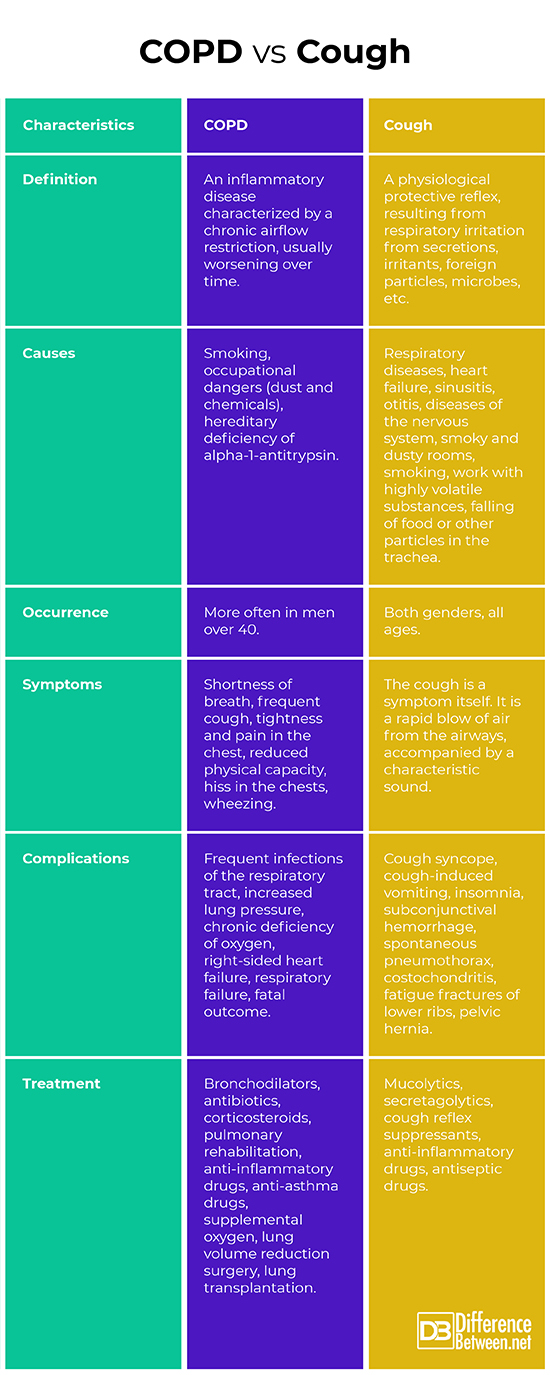Difference Between COPD and Cough
What is COPD?
Chronic obstructive pulmonary disease (COPD) is an inflammatory disease characterized by a chronic airflow restriction, usually worsening over time. The main symptoms are shortness of breath, cough, and expectoration.
COPD is an umbrella term describing a group of lung diseases including chronic bronchitis, emphysema, and refractory asthma.
In emphysema, the alveoli are damaged. Their walls become stretched out and the lungs enlarge. A certain amount of air gets trapped in the lung and blocks the alveoli, making the breathing difficult.
Chronic bronchitis is an inflammation of the bronchial airways, which limits the air flow and makes the breathing hard.
Refractory asthma is not influenced by common asthma medications. In an attack of refractory asthma, the medications do not reverse the swelling and tightening of the airways.
The most common patients with COPD are men over 40 years of age, but the disease can affect both genders and different ages.
The main causes of COPD are smoking and some occupational dangers, like dust and chemicals. The hereditary deficiency of alpha – 1 – antitrypsin can also cause COPD.
The symptoms of COPD can vary from person to person. The most common symptoms include:
- Shortness of breath;
- Frequent cough;
- Tightness and pain in the chest;
- Reduced physical capacity;
- Hiss in the chests;
- Wheezing.
The complications of COPD are:
- Frequent infections of the respiratory tract;
- Increased lung pressure;
- Chronic deficiency of oxygen;
- Right-sided heart failure;
- Respiratory failure and fatal outcome.
The different types of COPD affect the overall condition of the patient differently. The success of the treatment, the progress and the impact of the symptoms on everyday life depend on the type of COPD.
COPD is still an incurable disease, but the severity of the symptoms and the progression of COPD can be managed with:
- Bronchodilators;
- Antibiotics;
- Corticosteroids;
- Pulmonary rehabilitation;
- Anti-inflammatory drugs;
- Anti-asthma drugs;
- Use of supplemental oxygen;
- Lung volume reduction surgery;
- Lung transplantation.
What is Cough?
Cough is a physiological protective reflex, resulting from respiratory irritation from secretions, foreign particles, microbes, and other irritants.
The cough is a complex reflex act designed to keep the throat and upper respiratory tract free. It is a rapid blow of air from the airways, accompanied by a characteristic sound. To some extent, the cough is a volitional act and can be arbitrarily induced or suppressed.
The cough is the most common and major symptom of the respiratory diseases, but can also occur in other conditions or illnesses.
Depending on the duration of the cough, it can be:
- Acute;
- Subacute;
- Chronic.
Depending on whether sputum is formed or not, a cough can be:
- Productive;
- Non-productive.
As a symptom, cough occurs in acute respiratory diseases, lung cancer, bronchial asthma, tuberculosis, etc. Coughing may be a sign of heart failure, a symptom of sinusitis, otitis, or diseases of the nervous system.
Smoky and dusty rooms, smoking, work with highly volatile substances, falling of food or other particles in the trachea can also lead to a cough.
A cough can result in acute or chronic complications:
- Cough syncope;
- Cough-induced vomiting;
- Insomnia;
- Subconjunctival hemorrhage;
- Spontaneous pneumothorax;
- Costochondritis;
- Fatigue fractures of lower ribs;
- Pelvic hernia.
The cough is not a disease and should not be necessarily treated. It is a protective mechanism of our organism, a signal that something is wrong. The treatment of a cough has to be based on the underlying cause. It can include:
- Mucolytics;
- Secretagolytics;
- Cough reflex suppressants;
- Anti-inflammatory drugs;
- Antiseptic drugs.
Difference Between COPD and Cough
-
Definition of COPD and Cough
COPD: COPD is an inflammatory disease characterized by a chronic airflow restriction, usually worsening over time.
Cough: Cough is a physiological protective reflex, resulting from respiratory irritation from secretions, irritants, foreign particles, microbes, and other irritants.
-
Causes
COPD: The most common causes of COPD are smoking and some occupational dangers, like dust and chemicals. The hereditary deficiency of alpha-1-antitrypsin can also cause COPD.
Cough: Cough is a common symptom of the respiratory diseases, but can also occur in other conditions or illnesses, like heart failure, sinusitis, otitis, or diseases of the nervous system. Smoky and dusty rooms, smoking, work with highly volatile substances, falling of food or other particles in the trachea can also lead to a cough.
-
Occurrence
COPD: The most common patients with COPD are men over 40 years of age.
Cough: Cough occurs in both genders and at all ages.
-
Symptoms
COPD: The most common symptoms of COPD include shortness of breath, frequent cough, tightness and pain in the chest, reduced physical capacity, hiss in the chests, wheezing.
Cough: The cough is a symptom itself. It is a rapid blow of air from the airways, accompanied by a characteristic sound.
-
Complications
COPD: The complications of COPD can be frequent infections of the respiratory tract, increased lung pressure, chronic deficiency of oxygen, right-sided heart failure, respiratory failure, fatal outcome.
Cough: The complications of a cough can be cough syncope, cough-induced vomiting, insomnia, subconjunctival hemorrhage, spontaneous pneumothorax, costochondritis, fatigue fractures of lower ribs, pelvic hernia.
-
Treatment for COPD and Cough
COPD: The severity of the symptoms and the progression of COPD can be managed with bronchodilators, antibiotics, corticosteroids, pulmonary rehabilitation, anti-inflammatory drugs, anti-asthma drugs, use of supplemental oxygen, lung volume reduction surgery, lung transplantation.
Cough: The treatment of a cough can include mucolytics, secretagolytics, cough reflex suppressants, anti-inflammatory drugs, antiseptic drugs.
COPD Vs. Cough
Summary of COPD Vs. Cough:
- COPD is an inflammatory disease characterized by a chronic airflow restriction, usually worsening over time.
- Cough is a physiological protective reflex, resulting from respiratory irritation from secretions, irritants, foreign particles, microbes, and other irritants.
- The causes of COPD are smoking, dust, chemicals, hereditary deficiency of alpha-1-antitrypsin. The cough is a symptom of respiratory diseases, heart failure, sinusitis, otitis, or diseases of the nervous system. Smoky and dusty rooms, smoking, work with highly volatile substances, falling of food or other particles in the trachea can also lead to a cough.
- The most common patients with COPD are men over 40 years of age. Cough occurs in both genders and at all ages.
- The most common symptoms of COPD include shortness of breath, frequent cough, tightness and pain in the chest, reduced physical capacity, hiss in the chests, wheezing. The cough is a symptom itself. It is a rapid blow of air from the airways, accompanied by a characteristic sound.
- The complications of COPD can be frequent infections of the respiratory tract, increased lung pressure, chronic deficiency of oxygen, right-sided heart failure, respiratory failure, fatal outcome. The complications of cough can be cough syncope, cough-induced vomiting, insomnia, subconjunctival hemorrhage, spontaneous pneumothorax, costochondritis, fatigue fractures of lower ribs, pelvic hernia.
- The severity of the symptoms and the progression of COPD can be managed with bronchodilators, antibiotics, corticosteroids, pulmonary rehabilitation, anti-inflammatory drugs, anti-asthma drugs, use of supplemental oxygen, lung volume reduction surgery, lung transplantation. The treatment of a cough can include mucolytics, secretagolytics, cough reflex suppressants, anti-inflammatory drugs, antiseptic drugs.
- Difference Between Gallstones and Cholecystitis - September 5, 2021
- Difference Between Constipation and Cramping - August 4, 2021
- Difference Between Whole Genome Sequencing and Microarray - May 6, 2021
Search DifferenceBetween.net :
Leave a Response
References :
[0]Haas, F., S. Haas, R. Human. The Chronic Bronchitis and Emphysema Handbook. 1st Edition. New York, Toronto: John Wiley and Sons, Inc. 2000. Print.
[1]Warrell, D., T. Cox, J. Firth. Oxford Textbook of Medicine, Vol. 2. Oxford: Oxford University Press. 2010. Print.
[2]Yankova, Z. New Guide to Pulmonary Diseases and Tuberculosis. Sofia: Medical University Press. 2012. Print.
[3]Image credit: https://www.flickr.com/photos/bjornmeansbear/720927442
[4]Image credit: https://commons.wikimedia.org/wiki/File:Copd_2010.jpg



